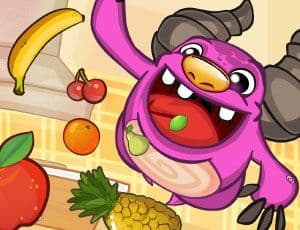Escola Games | Jogos Educativos
https://www.escolagames.com.br
Teacher's support sheet

Eating Fruit Monster
This little monster loves to eat fresh fruit. To help it, click and hover over the green balloon to find out which fruit they’re going to eat. You’re going to help the monster eat a snack and learn about different fruits. Now, hurry up! The Eating-fruit Monster is hungry!

Teacher's tips
Level of Education: Elementary School
Subject: English - Science
Theme: Human Being and Health - Literacy - Spelling
Age: 06 a 08 years old
Fruits are one of the most important parts of children's diets. They are low in fat and calories and provide the main nutrients children need to grow up. They also help protect from certain diseases. That is why it is so important to teach children the benefits of these foods. This game brings an interdisciplinary proposal involving healthy eating, fruit benefits, and reading.
This animation encourages students to think about the importance of fruits in our food. [FIM-DICA]
Learner outcomes
To understand the importance of healthy eating;
To learn about fruits and their significance for human health;
To motivate children to have good eating habits with the intake of fruits;
To comprehend the benefits that each of the fruits brings to our health;
To develop the ability to read, interpret, and understand small texts;
To recognize the different types of fruits and associate their names with the images;
To reinforce content discussed during the classes;
To develop motor skills.
Teachers' goals
To show students the importance of fruits for humans;
To motivate the child to have good eating habits with the intake of fruits;
To provide moments of reflection on the importance of food for our health and nature;
To offer the game as a didactic resource to explore the content discussed in the classroom;
To widen students' knowledge;
To encourage students to recognize fruits as a healthy source;
To enable contact with reading, from small texts with nutritional information about fruits;
To help students improve their motor skills.
Suggestions of approaches for the teacher
(Approach 1) Before playing, talk to students about their eating. What do they usually eat? How many meals do they eat per day? What foods do they think are healthy? Do they think it's important to eat healthy foods? Is their food healthy? Why? Do we need to eat fruits? Why? At what time of day is it best to eat fruit? Can we eat fruit at every meal? Which fruits do they like best? Which do they dislike?
As children speak, write down the names of the fruits on the board. It is necessary to know about all fruits to guide and respond to children. For this game, it is necessary that the student is at a good level of writing and has basic reading and writing skills, as they will have to interpret some facts.
(Approach 2) Divide the class into pairs. Encourage students to read the information about all the fruits. Students must take turns to discover each of the fruits. At the reading stage, a classmate should help the other.
(Approach 3) During the activity, give children a sheet with a table and names of the fruits of the game.
(Approach 4) Take different fruits to the classroom for students to experience their texture, color, and smell. You can blindfold students and ask them to discover the fruit by smell, texture, or taste. It is an activity that you can combine with the contents of healthy eating and the five senses.
(Approach 5) Organize a visit to the fruit market and bring money. Each student should buy a fruit to prepare a salad fruit at school.
(Approach 6) Observe fruits, their pulp, and seeds. Talk to children and ask them to write about each fruit: the color, smell, taste, seeds, and peel. Then, complete the notes with the information on the game “Monster eats fruit.”
(Approach 7) Invite a nutritionist or a pediatrician to talk to children about the importance of fruits. Prepare this interview with students, explaining what they will ask, how to behave, etc.
(Approach 8) Photograph this project's activities and print some children to create a caption.
(Approach 9) Assemble a chart with students' favorite fruits. Interview other classes for this activity. You can do the chart at https://www.canva.com/.
(Approach 10) Research the region each fruit grows and the time of planting.
(Approach 11) Write the names of the fruits on the board. Tell students to organize them into alphabetical order, then choose three of them and write a sentence.
(Approach 14) Elaborate a crossword with the names of the fruits.
(Approach 15) Fruit memory game. Form the pairs like in the game " Monster eats Fruit": draw the fruit on a card and on its pair write a small text with its characteristics and nutrients.
(Approach 16) Ask each student to bring a liter of natural fruit juice. Promote a fun afternoon with healthy food.
More about the content
CURIOSITY ABOUT FRUITS
Strawberries are the only fruit with seeds on the outside. There are 200 seeds in an average strawberry.
Red fruits keep your heart strong.
Orange fruits tend to keep your eyes healthy.
Yellow fruits prevent you from getting sick.
Green fruits help strengthen bones and teeth.
Purple and blue fruits help improve memory.
Orangutans love to eat mangoes! Mango is the most loved and number one fruition Earth.
Dark green vegetables have more vitamin C when compared to light-colored vegetables.
Apples float in the water because they are 25% air.
A kiwi has twice as much vitamin C present in an orange.
Pineapples are berries. You can accelerate their ripening by making them stand upside down (leaf side down).
Horticulturists think that bananas were the first fruit on earth.
Dried fruits have more calories than fresh fruits because the drying process reduces water content and volume.
Half a cup of figs has the same amount of calcium as half a cup of milk.
Lychee seeds are poisonous and should not be consumed.
A cucumber is not a vegetable but a fruit.
Tomatoes are not a vegetable but fruit. They are considered the most popular fruit in the world and have more genes than humans.
Eating an apple is a more reliable method of staying awake than consuming a cup of coffee, as it gives you more energy. The natural sugar in an apple is more potent than the caffeine in coffee.
